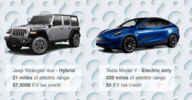What a load! What difference does the number of seats make? If I take the third row of seats out of a Tahoe or Explorer it's no longer an SUV?
I will be interested if this is changed, or if the IRS is now part of the anti-Tesla club.
If I were a betting man, the 7 seater is likely falling under van specification ($80 MSRP limit for vans.) I believe DOT classifies any vehicle that seats more than 5, but less than 10, as MPV (the same category as minivans.) The Y is pretty close to some minivans in dimensions and ground clearance, it just doesnt have a sliding door. In fact, if you go on the NHTSA website, you can find initial assessment docs for the Model Y that refer to it as a MPV (not a SUV.)
All OEMs had to be aware of these pre-defined classifications as they have been in use for CAFE regulations (for decades.) Realistically, with the larger bill attempting to curb inflation as a whole, the Y at $55K probably isnt unreasonable. It was close to that in December with Tesla incentives and was around that price a little bit over a year ago.
Last edited:



